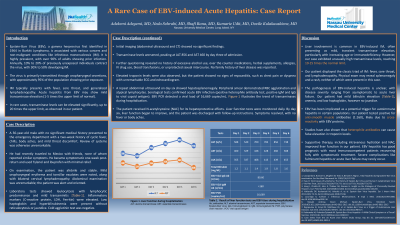Monday Poster Session
Category: Liver
P3136 - A Rare Case of EBV-Induced Acute Hepatitis
Monday, October 28, 2024
10:30 AM - 4:00 PM ET
Location: Exhibit Hall E

Has Audio

Neda Sohrabi, MD
Nassau University Medical Center
East Meadow, NY
Presenting Author(s)
Adekemi Adeyemi, MD, Neda Sohrabi, MD, Kumarie Udit, MBBS, Shafi S. Rana, MD, Dovil Kulakauskiene, MD
Nassau University Medical Center, East Meadow, NY
Introduction: Epstein-Barr Virus (EBV) is a common cause of infectious mononucleosis (IM). It is generally transmitted via oropharyngeal secretions and highly prevalent (~ 95% of the healthy population has evidence of prior infection with EBV). Acute hepatitis induced by EBV often manifests with slightly raised transaminase levels (approximately 1-5 times the upper limit of normal). However, in some cases, patients may exhibit significantly elevated transaminase levels (up to 20 times the upper limit of normal), as observed in our case.
Case Description/Methods: A 30-year-old man presented with a two-week history of cyclic fever, chills, body aches, and mild throat discomfort after recent travel to Mexico. Examination showed mild oropharyngeal erythema, tonsillar exudates, and bilateral cervical lymphadenopathy. Lab tests revealed leukocytosis with lymphocyte predominance, mild transaminitis, elevated inflammatory markers, low haptoglobin, and hyperbilirubinemia without reticulocytosis or jaundice. Initial imaging, including abdominal US and CT scan revealed no significant findings. By 3rd day of admission, ALT and AST levels peaked at 856 and 460, respectively. A repeat US revealed hepatosplenomegaly. Peripheral smear demonstrated RBC agglutination with atypical lymphocytes. Serological tests confirmed acute EBV infection with a positive Monospot test, EBV-specific IgM and IgG antibodies, and an EBV PCR viral load of 16,669 copies/mL. NAC protocol was initiated as well as supportive care. By day 6 of admission, LFTs improved and patient was discharged.
Discussion: EBV, a common cause of IM, is characterized by a triad of fever, sore throat, and lymphadenopathy. Liver involvement is common in most cases IM, however, it typically is transient with mild elevation in transaminases of 1-5 times the upper limit of normal. Our case is an unusual presentation with transaminase levels elevated 10-15 times the upper limit of normal. Investigations ruled out other causes of acute hepatitis, including hepatotropic viruses, alcohol, drugs/toxins, and metabolic factors. Although our patient had mild elevation in total bilirubin, anemia and low haptoglobin, he had no clinical signs of jaundice. Interestingly, our patient initially tested positive for anti-smooth muscle antibody likely due to cross-reactivity between EBV proteins and autoantigens. Prognosis for EBV hepatitis is typically very good, with most patients recovering completely, although rare cases of acute liver failure have been reported.
Note: The table for this abstract can be viewed in the ePoster Gallery section of the ACG 2024 ePoster Site or in The American Journal of Gastroenterology's abstract supplement issue, both of which will be available starting October 27, 2024.
Disclosures:
Adekemi Adeyemi, MD, Neda Sohrabi, MD, Kumarie Udit, MBBS, Shafi S. Rana, MD, Dovil Kulakauskiene, MD. P3136 - A Rare Case of EBV-Induced Acute Hepatitis, ACG 2024 Annual Scientific Meeting Abstracts. Philadelphia, PA: American College of Gastroenterology.
Nassau University Medical Center, East Meadow, NY
Introduction: Epstein-Barr Virus (EBV) is a common cause of infectious mononucleosis (IM). It is generally transmitted via oropharyngeal secretions and highly prevalent (~ 95% of the healthy population has evidence of prior infection with EBV). Acute hepatitis induced by EBV often manifests with slightly raised transaminase levels (approximately 1-5 times the upper limit of normal). However, in some cases, patients may exhibit significantly elevated transaminase levels (up to 20 times the upper limit of normal), as observed in our case.
Case Description/Methods: A 30-year-old man presented with a two-week history of cyclic fever, chills, body aches, and mild throat discomfort after recent travel to Mexico. Examination showed mild oropharyngeal erythema, tonsillar exudates, and bilateral cervical lymphadenopathy. Lab tests revealed leukocytosis with lymphocyte predominance, mild transaminitis, elevated inflammatory markers, low haptoglobin, and hyperbilirubinemia without reticulocytosis or jaundice. Initial imaging, including abdominal US and CT scan revealed no significant findings. By 3rd day of admission, ALT and AST levels peaked at 856 and 460, respectively. A repeat US revealed hepatosplenomegaly. Peripheral smear demonstrated RBC agglutination with atypical lymphocytes. Serological tests confirmed acute EBV infection with a positive Monospot test, EBV-specific IgM and IgG antibodies, and an EBV PCR viral load of 16,669 copies/mL. NAC protocol was initiated as well as supportive care. By day 6 of admission, LFTs improved and patient was discharged.
Discussion: EBV, a common cause of IM, is characterized by a triad of fever, sore throat, and lymphadenopathy. Liver involvement is common in most cases IM, however, it typically is transient with mild elevation in transaminases of 1-5 times the upper limit of normal. Our case is an unusual presentation with transaminase levels elevated 10-15 times the upper limit of normal. Investigations ruled out other causes of acute hepatitis, including hepatotropic viruses, alcohol, drugs/toxins, and metabolic factors. Although our patient had mild elevation in total bilirubin, anemia and low haptoglobin, he had no clinical signs of jaundice. Interestingly, our patient initially tested positive for anti-smooth muscle antibody likely due to cross-reactivity between EBV proteins and autoantigens. Prognosis for EBV hepatitis is typically very good, with most patients recovering completely, although rare cases of acute liver failure have been reported.
Note: The table for this abstract can be viewed in the ePoster Gallery section of the ACG 2024 ePoster Site or in The American Journal of Gastroenterology's abstract supplement issue, both of which will be available starting October 27, 2024.
Disclosures:
Adekemi Adeyemi indicated no relevant financial relationships.
Neda Sohrabi indicated no relevant financial relationships.
Kumarie Udit indicated no relevant financial relationships.
Shafi Rana indicated no relevant financial relationships.
Dovil Kulakauskiene indicated no relevant financial relationships.
Adekemi Adeyemi, MD, Neda Sohrabi, MD, Kumarie Udit, MBBS, Shafi S. Rana, MD, Dovil Kulakauskiene, MD. P3136 - A Rare Case of EBV-Induced Acute Hepatitis, ACG 2024 Annual Scientific Meeting Abstracts. Philadelphia, PA: American College of Gastroenterology.
